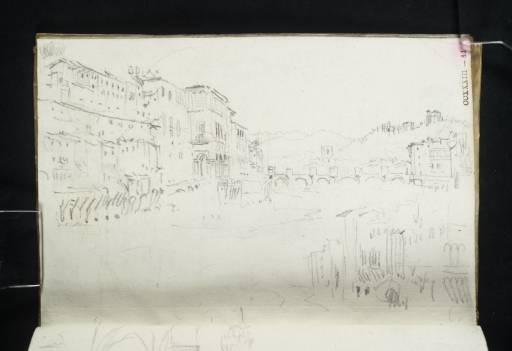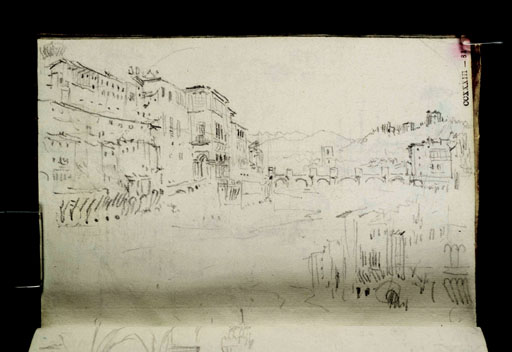Joseph Mallord William Turner The Uffizi Gallery and the Ponte alle Grazie, from the Ponte Vecchio, Florence 1828
Image 1 of 2
Joseph Mallord William Turner,
The Uffizi Gallery and the Ponte alle Grazie, from the Ponte Vecchio, Florence
1828
Folio 81 Recto:
The Uffizi Gallery and the Ponte alle Grazie, from the Ponte Vecchio, Florence 1828
D21565
Turner Bequest CCXXXIII 81
Turner Bequest CCXXXIII 81
Pencil on white lined wove paper, 96 x 144 mm
Inscribed in red ink ‘81’ (smudged) top right, ascending vertically
Stamped in black ‘CCXXXIII – 81’ top right, ascending vertically
Inscribed in red ink ‘81’ (smudged) top right, ascending vertically
Stamped in black ‘CCXXXIII – 81’ top right, ascending vertically
Accepted by the nation as part of the Turner Bequest 1856
References
1909
A.J. Finberg, A Complete Inventory of the Drawings of the Turner Bequest, London 1909, vol.II, p.717, CCXXXIII 81, as ‘Ponte Vecchio, at Florence’.
1984
Cecilia Powell, ‘Turner on Classic Ground: His Visits to Central and Southern Italy and Related Paintings and Drawings’, unpublished Ph.D thesis, Courtauld Institute of Art, University of London 1984, pp.302 note 25, 434.
1987
Cecilia Powell, Turner in the South: Rome, Naples, Florence, New Haven and London 1987, pp.[139], 206 note 18.
As identified by Finberg in his 1909 Inventory of the Bequest, Turner achieved this viewpoint from halfway along the Ponte Vecchio, which crosses the River Arno in Florence.1 The only medieval bridge in the city to survive the Second World War, it is now a popular landmark famed for its rows of shops and goldsmithing traditions. On the page opposite, folio 80 verso (D21564), Turner produced a variant study from a similar vantage point, detailing the bridge’s three central arches in the foreground. Here, the arches are omitted to allow for a more architecturally detailed panorama of the riverside buildings along the present-day Lungarno degli Archibusieri.
Facing south-east, Turner sketched the River Arno and the neighbouring bridge, the Ponte alle Grazie. As shown here, evenly spaced chapels and dwelling houses once stood along the Ponte alle Grazie; these were cleared in the 1870s, and the entire bridge was later rebuilt following its destruction during the Second World War. The distant tower beyond is the Porta San Niccolò.
The riverside buildings detailed to the left include, at the centre, the three-storey Uffizi gallery, commissioned by Cosimo I de’ Medici and built in the mid sixteenth century to designs by Giorgio Vasari.2 Further unidentified buildings appear in the bottom-right corner.
For a general commentary on Turner’s second visit to Florence in 1828, his first encounter with the city in 1819, and a list of relevant works in the present sketchbook, see under folio 2 verso (D21415).
Hannah Kaspar
November 2024
‘The Uffizi Palace’, Le Gallerie degli Uffizi, accessed 2 May 2024, https://www.uffizi.it/en/artworks/ll-palazzo-degli-uffizi .
How to cite
Hannah Kaspar, ‘The Uffizi Gallery and the Ponte alle Grazie, from the Ponte Vecchio, Florence 1828’, catalogue entry, November 2024, in David Blayney Brown (ed.), J.M.W. Turner: Sketchbooks, Drawings and Watercolours, Tate Research Publication, February 2025, https://www


